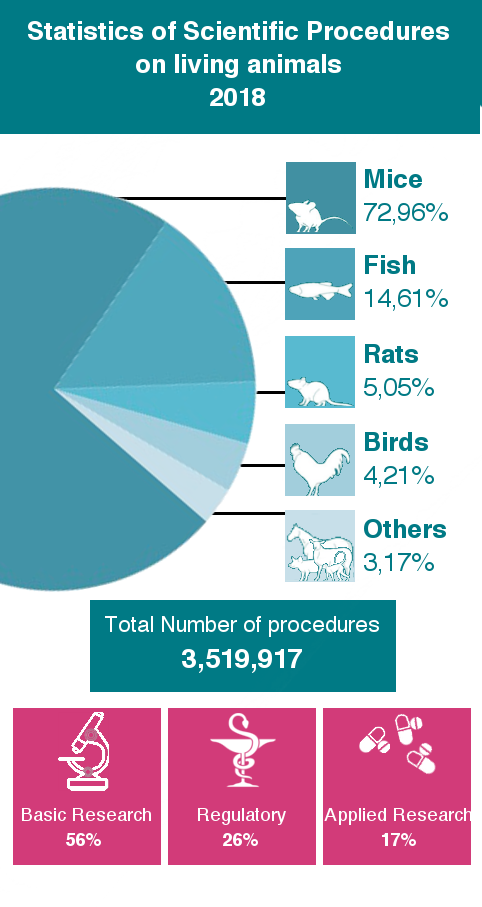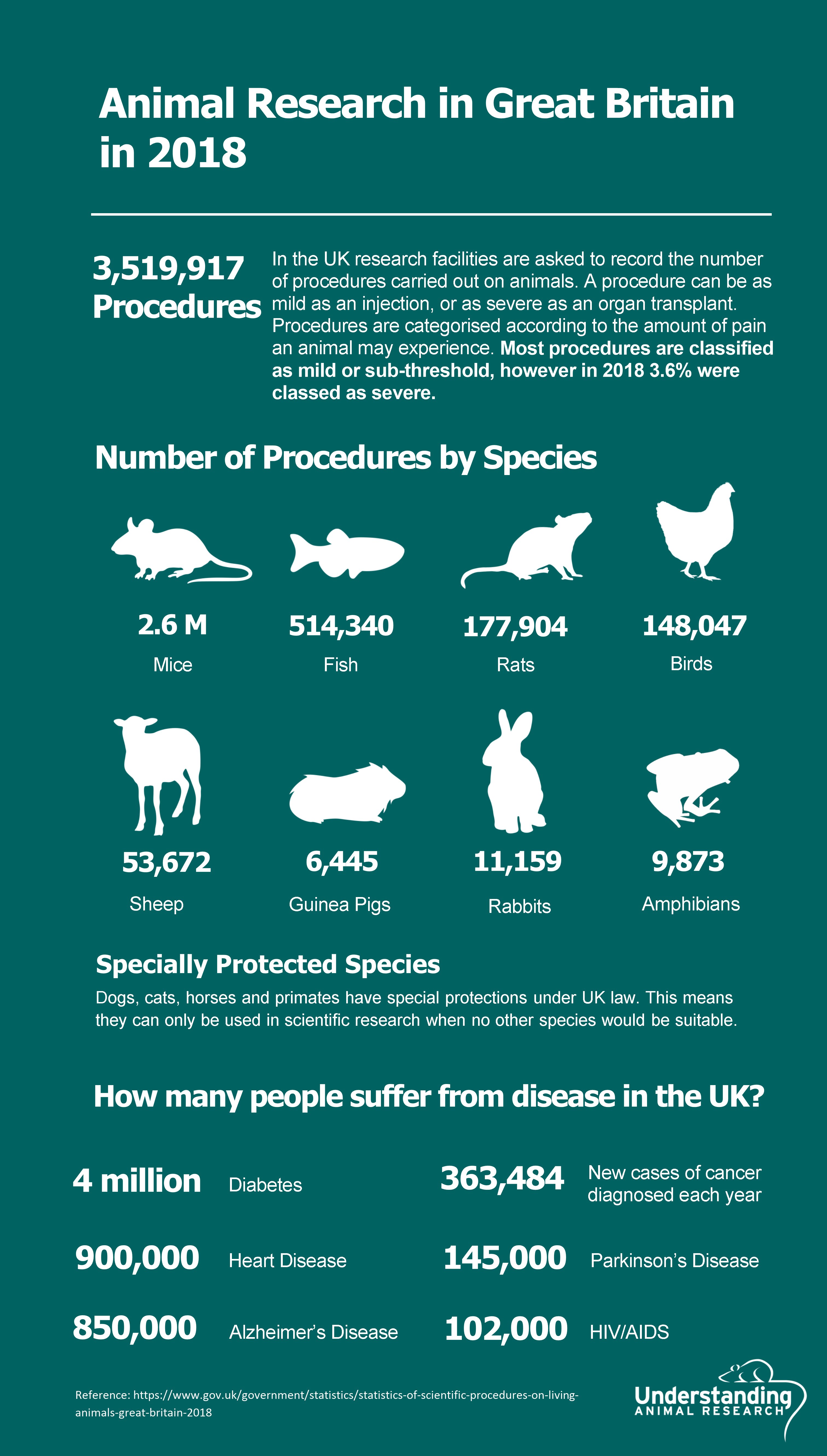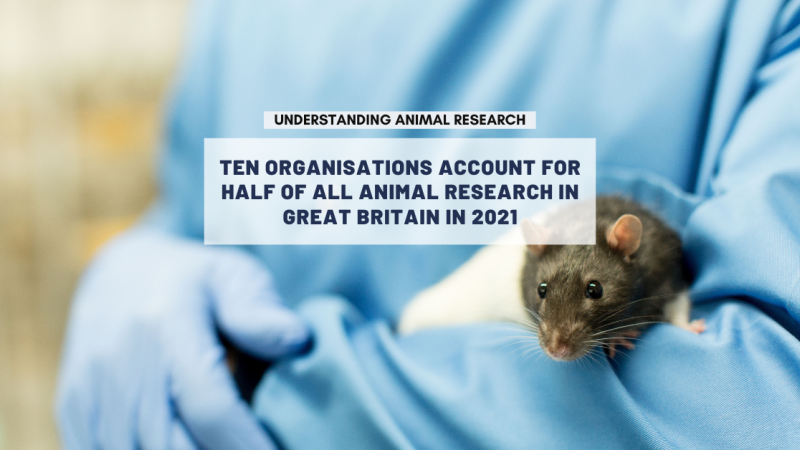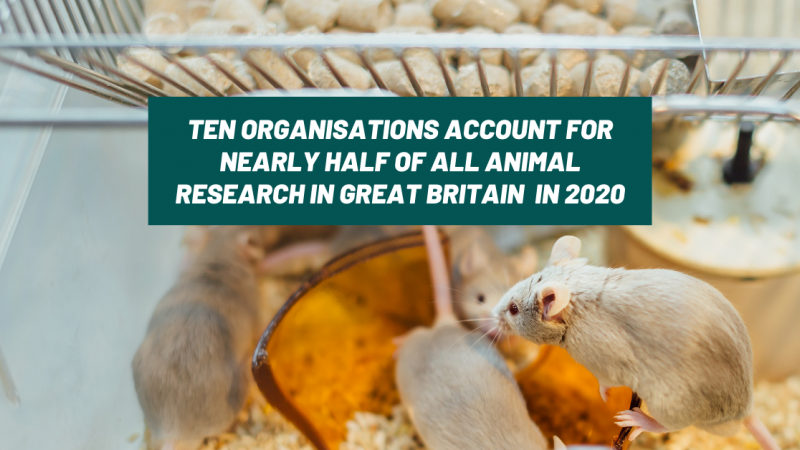Latest figures show fewer animals used in research in 2018
- Number of procedures on animals has decreased by 7% to 3.52 million
- Lowest number of procedures carried out in a single year since 2007
- Mice, fish, rats, and birds account for over 97% of all procedures
- Dog and primate use up 16% and 8% respectively
Today (Thursday, 18 July 2019) the government has released its annual statistics on the number of animals used in scientific, medical and veterinary research in 2018. The figures show that 3,519,917 procedures were carried out in Great Britain in 2018, 7% fewer than in 2017.
Nearly half of these procedures were carried out by ten organisations.
Over 97% of procedures were carried out on mice, fish, rats and birds whereas cats, dogs and primates accounted for less than 0.2% of all procedures.
|
Number of Animal Procedures in Great Britain in 2018 |
|||||||
|
Species |
Experimental Procedures |
% | Procedures for the Creation & Breeding of Genetically Altered Animals | % |
Total Procedures (2018) |
% of total |
% change from 2017 |
|
Mice |
1,078,738 |
59.86% |
1,489,459 |
86.7% |
2,568,197 |
72.96% |
-7.67% |
|
Fish |
297,811 |
16.53% |
216,529 |
12.6% |
514,340 |
14.61% |
+0.05% |
|
Rats |
170,665 |
9.47% |
7,239 |
0.42% |
177,904 |
5.05% |
-26.35% |
|
Birds |
146,860 |
8.15% |
1,187 |
0.07% |
148,047 |
4.21% |
+12.15% |
|
Other mammals |
82,754 |
4.59% |
427 |
0.02% |
83,181 |
2.36% |
-10.51% |
|
Reptiles |
104 |
0.01% |
0 |
0% |
104 |
0.003% |
+13.04% |
|
Amphibians |
6,827 |
0.38% |
3,046 |
0.18% |
9,873 |
0.28% |
+4.69% |
|
Primates |
3,207 |
0.18% |
0 |
0% |
3,207 |
0.09% |
+8.34% |
|
Cats |
159 |
0.01% |
0 |
0% |
159 |
0.005% |
-19.70% |
|
Dogs |
4,481 |
0.25% |
0 |
0% |
4,481 |
0.13% |
+16.48% |
|
Horses |
10,424 |
0.58% |
0 |
0% |
10,424 |
0.30% |
-1.66% |
|
Total |
1,802,030 |
1,717,887 |
3,519,917 |
100% |
-7.11% |
||
There was a 16% rise in the number of procedures on dogs (4,481 procedures) and an 8% rise in the number of procedures on primates (3,207 procedures) compared to the previous year. 2017 saw a 22% decrease in the number of procedures on dogs and a 17% decrease in the numbers of procedures on primates when compared to 2016. Despite a rise in 2018, procedures in dogs and primates are still 24% and 25% lower, respectively, compared to ten years ago.
Procedures in dogs and primates have been essential for scientific, medical and veterinary research. Dogs are currently being used to develop treatments for Duchenne muscular dystrophy, a debilitating muscle wasting disease that has no cure and ultimately leads to early death. Like humans, non-human primates (NHPs) have a prefrontal cortex, which is the part of the brain involved in cognitive behaviour. This means that NHPs can help scientists understand how the brain works and help us develop treatments for neurological conditions like Alzheimer’s, Parkinson’s and OCD.
Half (1.72 million) of all procedures for were the creation or breeding of genetically altered (GA) animals. These procedures fell by 185,553, while the number of experimental procedures (1.8 million) fell by 83,903. Experimental procedures include basic and applied research, and regulatory studies aimed at ensuring product safety.
The use of animals to test tobacco products was banned in the UK in 1997 and it has been illegal to use animals to test cosmetic products in this country since 1998. A policy ban on household product testing using animals was introduced in 2010. Since 2013, it has been illegal to sell or import cosmetics anywhere in the EU where the finished product or its ingredients have been tested on animals.
|
Severity of Animal Procedures in Great Britain in 2018 |
||||||
|
Severity |
Experimental Procedures |
% | Procedures for the Creation & Breeding of Genetically Altered Animals | % |
Total Procedures (2018) |
Change from 2017 |
|
Sub Threshold |
186,011 |
10.3% |
1,229,656 |
71.6% |
1,415,657 (40.2%) |
↓ |
|
Non-Recovery |
90,054 |
5% |
505 |
0.03% |
90,559 (2.6%) |
↓ |
|
Mild |
961,246 |
53.3% |
409,303 |
23% |
1,370,549 (39%) |
↑ |
|
Moderate |
477,162 |
26.5% |
40,560 |
2.4% |
517,722 (14.7%) |
= |
|
Severe |
87,557 |
4.9% |
37,863 |
2.2% |
125,420 (3.6%) |
= |
The proportion of animal research categorised as Mild rose from 35.7% in 2017 to 39% in 2018. The proportion of procedures categorised as Severe and Moderate remained the same when compared to 2017.
Animals are used alongside other techniques such as cell cultures, human studies and computational models. These methods are used – often in tandem – to answer the key biological questions necessary to understand and treat disease.
Animal research is strictly regulated in the UK. Every procedure, from a simple blood test to major surgery, requires individual, establishment and project licences, as well as approval from an Animal Welfare and Ethical Review Body. Before an animal is used, researchers must show that the knowledge could not be acquired using non-animal methods.

While the government produces these statistics on an annual basis, more organisations than ever before are openly publishing their own figures on their websites. This move towards greater transparency has been bolstered by the Concordat on Openness on Animal Research in the UK, which has been signed by 121 organisations since it launched in 2014.
Wendy Jarrett, Chief Executive, Understanding Animal Research, said:
"These figures show once again that experiments using mice, rats, fish and birds make up 97% of animal research in this country. However, people will be pleased to know that millions of pounds are invested every year in finding non-animal alternatives, which help to bring the numbers of animals used down over time. This sets the right balance between preventing and treating human and animal diseases, while ensuring that animals are only used when absolutely necessary."

Last edited: 16 August 2022 14:30




